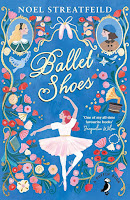 |
| (Amazon UK link) |
‘Ballet Shoes’ is Streatfeild’s best-known novel. First published in 1936, it has had some recent popularity due, in part, to the excellent adaptation by the BBC. It’s set initially in the 1920s, introducing the eccentric Great Uncle Matthew (known as GUM) whose niece Sylvia looks after his large house with its collection of fossils, collected from all over the world. When GUM manages to damage a leg, he starts travelling in ships, and instead of collecting fossils, he acquires - over a period of several years - three babies whom he brings to Sylvia to look after.
Pauline is the oldest; she’s attractive and bright, and overall a likeable child. Petrova, daughter of Russians, is the next; she’s thin and less obviously attractive, but extremely intelligent. Posy is the youngest, the daughter of a ballet dancer who cannot afford to keep her. Adoption was evidently quite straightforward in this era, or perhaps the author skated lightly over the procedures.
In any case, the story really gets going when Posy is nearly six, Petrova nearly eight, and Pauline approaching ten. They have been brought up by Nana, Sylvia’s old nurse, as respectable middle class children, with Pauline and Petrova attending a local private school. However, by this stage GUM has been gone for nearly six years, and the money he left for the children’s upkeep has just about gone.
So Sylvia decides to take in boarders. Two of them are, conveniently, retired lecturers: one specialising in literature and the other in maths. They offer to home educate the two older girls, while Sylvia teaches Posy. And another boarder, a ballet teacher, manages to get places for the three girls at a theatre/dance school nearby, in the hope that they can start earning some money when they are old enough for licenses.
Much of the novel is about the children’s varying experiences at the theatre school, where Pauline stands out as an excellent actress, and Posy as a potential ballet star. Petrova, a classic middle child, has no interest in either; she would prefer to get her hands greasy while helping to mend cars. The appeal of the story is in the relationships between the three very different children, and they way they tackle problems. Admittedly there’s some caricaturing, but there’s also a great deal of warmth and affection.
As a piece of social history, this - along with the author’s other books - is excellent. The background of London in the period between the wars is clearly shown, as is a typical impoverished household struggling to make ends meet. Nana has high standards for her charges, and expects them to be clean, polite and well-behaved, even if wearing threadbare clothes that have been mended many times, and in some cases are rather too small.
Steatfeild evidently had plenty of experience in theatre life; her scenes set on stages or auditoriums feel as natural as those in school or home. The pace of the book is excellent, covering the years until Pauline is in her mid-teens. I last read ‘Ballet Shoes’ in 2006, and while the overall story was familiar to me there were many conversations and other details which I had forgotten. All in all it made an ideal light read for a day when I wasn’t feeling well and needed something comforting and unthreatening.
Originally written for girls between the ages of about eight and fourteen, this would probably appeal to those of any age who read avidly and like this kind of gentle, but thoughtful story. It would make a great read-aloud, too, for children of any age. There are plenty of moral lessons imparted by Nana, but they’re not intrusive in my view. It’s a pleasantly nostalgic book which harks back to a simpler era - yet one where life for many was extremely difficult.
As with many of this author’s books, the ending chapter is somewhat abrupt. Several threads come together, and one problem is solved by a kind of deus ex machina appearance which isn’t entirely convincing in my view. But everything is neatly tied up, with plans for the future, and we don’t really need to know any more.
Highly recommended. Regularly in print in various editions, as well as widely available second-hand.
Review copyright 2018 Sue's Book Reviews
No comments:
Post a Comment